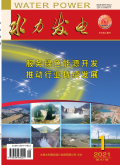水力发电2024,Vol.50Issue(1):20-25,70,7.
显式算法中三维黏弹性人工边界应用及输水隧洞动力响应分析
Application of 3D Viscoelastic Artificial Boundary and Dynamic Response Analysis of Water Conveyance Tunnel in Explicit Algorithm
摘要
Abstract
In order to ensure the stability and efficiency of dynamic response analysis of large and complex three-dimensional finite element models combined with two-dimensional viscoelastic boundary theory and its stability improvement method in the explicit analysis of dynamics a three-dimensional viscoelastic artificial boundary method suitable for ABAQUS/Explicit module is proposed and the vibration characteristics of high-speed train vibration load on existing hydraulic tunnels are studied on the basis of three-dimensional viscoelastic boundaries based on the interchange project of a water transmission tunnel and adjacent high-speed rail tunnels.The results show that when the dynamic explicit analysis is adopted the viscoelastic artificial boundary with improved stability has a good energy absorption effect which satisfies the resilience energy of distant foundations the dynamic influence of vibration load on water conveyance tunnel decreases with the increase of operating distance and the extreme values of dynamic response of each section appear in the center of bottom plate.关键词
输水隧洞/动力响应/黏弹性人工边界/三维有限元/显式算法Key words
water conveyance tunnel/dynamic response/viscoelastic artificial boundary/3D finite element/explicit algorithm分类
水利科学引用本文复制引用
陈旻铭,任旭华,张继勋..显式算法中三维黏弹性人工边界应用及输水隧洞动力响应分析[J].水力发电,2024,50(1):20-25,70,7.基金项目
中央高校基本科研业务费专项资金资助项目(B220-204001) (B220-204001)
云南省重大科技专项计划项目(202102AF080001) (202102AF080001)

